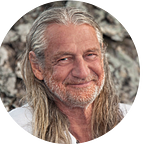The Asana Files: Mahamudra and Kundalini | Mark Whitwell
Mahamudra is known in the Yoga traditions as ‘the great sacred gesture.’ It is a highly revered asana that is placed at the conclusion of one’s vinyasa. Unlike a seated forward bend, the spine remains straight.
The posture earns the title ‘great sacred gesture’ because it is the literal enactment of the head/mind given over to its source: the Hridaya Heart; the first cell of life that appeared when you appeared; the portal through which Nurturing Source Reality flows and manifests as the whole body.
Mahamudra practiced correctly involves the activation of all three bandhas. Among asana, only two others share this feature: the others are Adho Mukha Svanasana (down dog) and Sarvangasana (shoulderstand).
The strength of the body base and the lower bandha — mulabandha and uddiyanabandha — rises to the Hridaya Heart as the ascending, male energy of strength. The head lowers to form jalandhara bandha thus giving over the descending energy of receptivity to the Heart.
The Heart resides at the place where the ascending and descending energies are perfectly merged. The whole body and mind is formed from the perfect flow of the Heart: nurturing prana blooming like a lotus flower that unfolds in all directions. This is kundalini.
As you practice, ensure that the breath the gauge to the asana. “Breath is guru.” The posture is organized by the breath ratio and the number of breaths that you are capable of doing without strain. “Obey your breath.”
Bandha is established in the retentions following the inhale and the exhale. The breath remains easy, smooth and full; never compromised by the length of retention or the placement of bandha.
As our practice develops and we become stronger it is likely that retentions with bandha will lengthen. By the same token, when there is less strength, retentions will shorten.
On exhale, lift the muladhara chakra to the agni, the fire of Life. All asana and pranayama exercises serve this cleansing action. The agni burns away the rubbish that has formed in the muladhara due to our reaction to experience.
The fire clears the nadis (the network through which prana moves). Prana now flows from Ida and Pingali, right to left, male to female, into the central spinal channel: the sushumna.
This asana is especially beneficial during pregnancy. The whole body is strengthened which supports the baby during birth and after.
In the Hathayogapradapika, mahamudra is praised as “like hitting kundalini with a stick, “she straightens.” That book however, was produced by a patriarchal male cult that had copied and distorted ancient Tantras in order to support their project that nature must be controlled and the feminine principle of Reality (the manifest, the Seen, the descent, the tangible) subjugated.
Its authors advocated for the sublimation of the “lower” gross chakras to awaken the “higher” more subtle chakras.
We can still easily detect this perspective today where the pursuit of the idea of enlightenement, “higher consciousness,” and the fixation on ascending energies, dominates and toxifies the public discourse on Yoga, meditation and religion.
Kundalini is awakened via participation in the intrinsic collaboration of he male-female polarity; participation, only; not a seeking. The ascending, male aspect of Life (felt through the exhale) is given over to the descending, female principle of Life; each empowers the other.
The primary method is the relationship embrace in the union of inhale with exhale. Asana and Pranayama practiced in a way that is right for you, reprograms the nervous system and the mind to give and receive, only.
Natural and perfect giving and receiving is the quality of the Hridaya Heart which is revealed as the source (seat) of the mind and of your Life.
Prana Shakti Kundalini flows from the Heart, the nurturing of all. In Reality, there is only the flow of nurturing. Kundalini arises from the heart not the base.
The primary Yoga is relationship itself. But if we have reacted and clogged our system with dross, mahamudra helps so that we can engage all experience with clarity and connection.
And so, we enjoy our life as the whole body, the whole person, where both male and female qualities of Life are entirely in Union and fully functioning within and without. All presumptions of limit dissolve.
*You are so welcome to join me and my friends in the heart of Yoga online studio for asana classes, conversations and community. We will endeavor to pass on to you what our teachers have given to us: the physical wisdom practices of indigenous pre-hierarchical cultures. Thank you.
